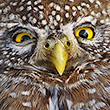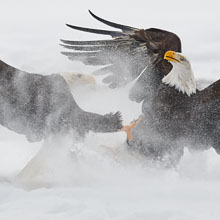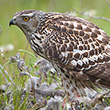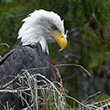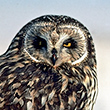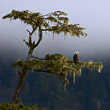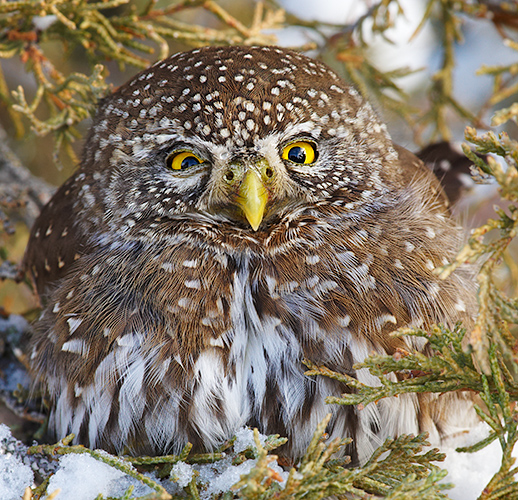
Availability: Undetermined - Enquiries?
In the Field
Northern Pygmy-Owl in Juniper. Findlay Creek, BC, Canada. February 6, 2008.
Way back in 1938 A.C. Bent referred to the Northern Pygmy-Owl as "...bloodthirsty, rapacious...fiend...from the top of its gory beak to the tips of its needle-like-claws" (from his seminal work entitled "Life histories of North American birds of prey"). While I have a hard time thinking of a cute tiny owl that stands only 10 cm (4") in height in such dramatic terms, I suppose if I were a chickadee or mouse I might think otherwise...
I captured this owl image just outside my cabin on a chilly, sub-zero February afternoon. I watched the owl land (after an unsuccessful but "feathers-flying" attack on a ground-foraging Mourning Dove) in the juniper and just sit. I gave the little fellow a few minutes to settle down before I began my approach. Because the juniper that held the "rapacious fiend" was on a steep downhill slope I had one option only - go in real close! So I fixed a short focal length lens (a 105 mm micro) and moved in almost painfully slowly. Eventually I was within about 18" from this little guy and shot several frames. When I withdrew the owl remained contently in place (for which I was glad - I'm not fond of disturbing my subjects).
This image was shot with a Nikon D3 - a high-speed camera designed for sports and action photography. I've been asked several times why I would want such a "speed demon" (both in terms of frames-per-second and high ISO performance) for nature photography. This image illustrates ONE of my reasons for using a D3. As previously mentioned, I had only one option in capturing this image - move in extremely close. From a distance of 18" the depth of field (DOF) of almost any lens is exceptionally shallow. About the only way I could produce an adequate DOF to keep enough of this owl in focus to make the image "work" was to stop the lens way down - in this case to f16. Even with this small aperture I had a total DOF of only 1.4 cm (0.55 inch). At f8 the DOF would have been only 0.7 cm (.28 inch) and at f2.8 the DOF would have been a paper-thin 0.25 cm (.1 inch). I experimented with using both f8 and f2.8 with this image. The results? In this situation so little of the tiny owl was in focus that the images simply weren't worth keeping.
So why is a D3 needed? The only way I could "find" this DOF and still keep a reasonably fast shutter speed (fast enough to freeze the movement in the fine feathers of the bird) was to select an ISO of 800. With the D3 ISO 800 produces extremely noise-free images (in fact, you can go easily up to ISO 1600 and still have very clean images with the D3). Nikon's previous pro cameras didn't really allow you shoot "clean" noise-free images with an ISO of 800 or more. In this situation the high ISO performance of the D3 gave me sufficient control over depth of field that I was able to capture an image I couldn't have previously.
Behind the Camera
Northern Pygmy-Owl in Juniper. Findlay Creek, BC, Canada. February 6, 2008.
Digital Capture; Compressed RAW (NEF) 14-bit format; ISO 800.
Nikon D3 with Nikon AF-S Micro 105 mm f/2.8G ED-IF N VR lens supported on Gitzo G2220 Explorer tripod with AcraTech Ultimate ballhead. VR turned to "On".
1/60s @ f16; -0.33 stop compensation from matrix-metered exposure setting.
At the Computer
Northern Pygmy-Owl in Juniper. Findlay Creek, BC, Canada. February 6, 2008.
RAW Conversion to 16 bit TIFF, including first-pass/capture sharpening, exposure compensation, and slight shadow/highlight adjustment using Phase One's Capture One 4. Multiple RAW conversions (2 at different exposure settings) in this case to adjust relative brightness of owl and foreground/background (see below).
Further digital correction on 16-bit TIFF file using Adobe's Photoshop CS3. Photoshop adjustments included compositing and masking of two exposure versions (at +0.3 stop for owl and -0.3 stop for foreground and background), selective curves adjustment, selective saturation enhancement and selective sharpening for web output.
Conservation
Northern Pygmy-Owl in Juniper. Findlay Creek, BC, Canada. February 6, 2008.
Species Status in Canada*: This species is not designated as at risk.
The Northern Pygmy-Owl (Glaucidium gnoma) is one of the least studied owls in the world - beyond the most basic facts (e.g., size and apparent diet) virtually nothing is known. Long distance movements and/or migratory patterns are unknown (by 1994 318 individuals had been banded, but none have ever been recovered). Similarly, while they APPEAR to be widely dispersed across western North America current population "guestimates" of the size of the number of breeding Pygmy-Owls in Canada varies between 2,000 and 10,000 pairs. Even the taxonomy of the Northern Pygmy-Owl is up for debate - some authors argue that 3 distinct species may occur in North America while others place them within a single species (with up to 7 sub-species!).
This Northern Pygmy-Owl was photographed in the Columbia Valley of the East Kootenays. While this species is currently not believed to be under direct risk of extinction, they are thought to be vulnerable to some forestry practices. Many ecosystems within the Columbia Valley face development pressure, including pressure from logging operations. Wildsight is an effective conservation organization that protects biodiversity and promotes sustainable communities in Canada's Columbia and Rocky Mountains. Support for Wildsight, through donation or becoming a member, will help ensure that they remain effective in their efforts to conserve threatened or endangered species and ecosystems.
*as determined by COSEWIC: The Committee on the Status of Endangered Wildlife in Canada



















